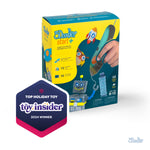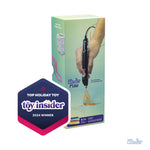Explore Earth Month projects and learn inventive techniques to maximize your creativity while keeping your environmental impact low by reusing everyday items.
We’re sharing how creators celebrate the planet by upcycling everyday materials to create impactful art. Turn ordinary objects and things around the house into cool, one-of-a-kind creations with 3Doodler project ideas.
Working for the Environment
The celebration of Earth Day began in April 1970 to push the federal government to tackle environmental issues. The response from the public was overwhelming, and in just a few short months, Congress authorized the creation of the Environmental Protection Agency (EPA).
The EPA serves a vital mission to protect human health and the environment. The agency does so by developing and enforcing regulations, giving grants, conducting research, creating partnerships, and educating people about the environment.
In seeking to educate the public, the EPA provides several resources for teachers and students to explore. For example, there are tips on conserving energy at home, becoming a food waste warrior, understanding our connection to groundwater, or even making a disaster readiness plan.
These resources are a fantastic way to bring environmental issues to the forefront and bring about change.
Repurpose & Reuse Everyday Items
3Doodler is committed to inspiring creativity while working with the environment, not against it. Our plastics promise outlines our work to ensure our plastics are completely safe to use. 3Doodler Start+ plastics are eco-friendly, and ALL of our plastics are certified as recyclable.
Now that you know the materials you’re using are safe for you and the environment, let’s get doodling. This round-up of projects encourages you to reuse or repurpose things around you as you create in 3D.

Give New Life To An Old Planter
Plants and greenery are a natural way to contribute to environmental efforts. Adding them to your home can add a beautiful natural element. Pick up an old pot or vase and give it new life with a 3D design. Add simple flowers along the outside or trim with polka dots, vines, or other creative symbols. It’s a wonderful opportunity to refresh an older item for a new use!

Turn Cardboard Scraps Into Speaker
Cardboard is an amazing material to work with to augment your 3D creations. It’s recycling in action. Find a few pieces of cardboard and make a DIY phone speaker that rocks. Use your 3D pen to add details to the speaker in colors that complement your space. It’s a unique way to reuse cardboard and amplify the music on your phone. Time to turn up the volume!

Transform Leftover Plastic
Collect doodled scraps as you create and learn to make new art with a few quick tips. From coasters to bowls and other eye-catching creations, there’s no end to what you can come up with using your plastic scraps. It’s a fantastic way to make the most of all your plastic. Play with different color combinations for your own truly unique recycled creations!




